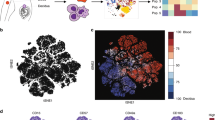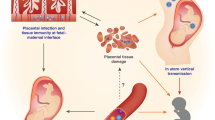Abstract
In humans, specific patterns of killer immunoglobulin-like receptors (KIRs) expressed by uterine natural killer (uNK) cells are linked through HLA-C with pregnancy complications (infertility, recurrent spontaneous abortion, intrauterine growth restriction and preeclampsia). To identify mechanisms underpinning the associations between NK cell activation and pregnancy success, pregnancies were studied in mice with genetic knockdown (KD) of the MHC-activated Ly49 receptor gene family. B6.Ly49KD pregnancies were compared to normal control B6.Ly49129 and C57BL/6 (B6) pregnancies. At mid-pregnancy (gestation day (gd9.5)), overall uNK cell (TCRβ−CD122+DBA+DX5− (DBA+DX5−)) and TCRβ−CD122+DBA−DX5+ (DBA−DX5+)) frequencies in pregnant uterus were similar between genotypes. Ly49KD lowered the normal frequencies of Ly49+ uNK cells from 90.3% to 47.8% in DBA−DX5+ and 78.8% to 6.3% in DBA+DX5− uNK cell subtypes. B6.Ly49KD matings frequently resulted in expanded blastocysts that did not implant (subfertility). B6.Ly49KD mice that established pregnancy had gestational lengths and litter sizes similar to controls. B6.Ly49KD neonates, however, were heavier than controls. B6.Ly49KD implantation sites lagged in early (gd6.5) decidual angiogenesis and were deficient in mid-pregnancy (gd10.5) spiral arterial remodelling. Ultrastructural analyses revealed that B6.Ly49KD uNK cells had impaired granulogenesis, while immunocytochemistry revealed deficient vascular endothelial cell growth factor (VEGFA) production. Perforin and IFNG expression were normal in B6.Ly49KD uNK cells. Thus, in normal mouse pregnancies, Ly49 receptor signaling must promote implantation, early decidual angiogenesis and mid-pregnancy vascular remodelling. Disturbances in these functions may underlie the reported genetic associations between human pregnancy complications and the inability of specific conceptus MHCs to engage activating KIR on uNK cells.
This is a preview of subscription content, access via your institution
Access options
Subscribe to this journal
Receive 12 digital issues and online access to articles
$119.00 per year
only $9.92 per issue
Buy this article
- Purchase on Springer Link
- Instant access to full article PDF
Prices may be subject to local taxes which are calculated during checkout






Similar content being viewed by others
References
Peel S, Granulated metrial gland cells. Adv Anat Embryol Cell Biol 1989; 115: 1–112.
Bulmer JN, Morrison L, Longfellow M, Ritson A, Pace D . Granulated lymphocytes in human endometrium: histochemical and immunohistochemical studies. Hum Reprod 1991; 6: 791–798
Gellersen B, Brosens IA, Brosens JJ . Decidualization of the human endometrium: mechanisms, functions, and clinical perspectives. Semin Reprod 2007; 25: 445–453.
Weir PE, Oats JN, Holdsworth R, Cross R . Histocompatibility antigens and intrauterine fetal growth retardation. Aust NZ J Obstetr Gynaecol 1985; 25: 108–110.
Hiby SE, Apps R, Sharkey AM, Farrell LM, Gardner L, Mulder A et al. Maternal activating KIRs protect against human reproductive failure mediated by fetal HLA-C2. J Clin Inv 2010; 120: 4102–4110.
Christiansen OB . Reproductive immunology. Mol Immunol 2013; 55: 8–15.
Hiby SE, Walker JJ, O'Shaughnessy KM, Redman CW, Carrington M, Trowsdale J et al. Combinations of maternal KIR and fetal HLA-C genes influence the risk of preeclampsia and reproductive success. J Exp Med 2004; 200: 957–965.
Parham P, Norman PJ, Abi-Rached L, Hilton HG, Guethlein LA . Review: immunogenetics of human placentation. Placenta 2012; 33( Suppl): 71–80.
Xiong S, Sharkey AM, Kennedy PR, Gardner L, Farrell LE, Chazara O et al. Maternal uterine NK cell-activating receptor KIR2DS1 enhances placentation. J Clin Invest 2013; 123: 28–30.
Bulmer JN, Innes BA, Levey J, Robson SC, Lash GE . The role of vascular smooth muscle cell apoptosis and migration during uterine spiral artery remodeling in normal human pregnancy. FASEB J 2012; 26: 2975–2985.
Li C, Houser BL, Nicotra ML, Strominger JL . HLA-G homodimer-induced cytokine secretion through HLA-G receptors on human decidual macrophages and natural killer cells. Proc Natl Acad Sci USA 2009; 106: 5767–72.
Hanna J, Goldman-Wohl D, Hamani Y, Avraham I, Greenfield C, Natanson-Yaron S et al. Decidual NK cells regulate key developmental processes at human fetal–maternal interface. Nat Med 2006; 12: 1065–1074.
Ashkar AA, Di Santo JP, Croy BA . Interferon gamma contributes to initiation of uterine vascular modification, decidual integrity, and uterine natural killer cell maturation during normal murine pregnancy. J Exp Med 2000; 192: 259–270.
Hofmann AP, Gerber SA, Croy BA . Uterine natural killer cells pace early development of mouse decidua basalis. Mol Hum Reprod 2013; 20: 66–76.
Tayade C, Hilchie D, He H, Fang Y, Moons L, Carmeliet P et al. Genetic deletion of placenta growth factor in mice alters uterine NK cells. J. Immunol 2007; 178: 4267–4275.
Zhang JH, Yamada AT, Croy BA . DBA-lectin reactivity defines natural killer cells that have homed to mouse decidua. Placenta 2009; 30: 968–973.
Paffaro Jr VA, Bizinotto MC, Joazeiro PP, Yamada AT . Subset classification of mouse uterine natural killer cells by DBA lectin reactivity. Placenta 2003; 24: 479–488.
Madeja Z, Yadi H, Apps R, Boulenouar S, Roper SJ, Gardner L . Paternal MHC expression on mouse trophoblast affects uterine vascularization and fetal growth. Proc Natl Acad Sci USA 2011; 108: 4012–4017.
Parr EL, Young LH, Parr MB, Young JD . Granulated metrial gland cells of pregnant mouse uterus are natural killer-like cells that contain perforin and serine esterases. J Immunol 1990; 145: 2365–2369.
Zheng LM, Joag SV, Parr MB, Parr EL, Young JD . Perforin-expressing granulated metrial gland cells in murine deciduoma. J Exp Med 1991; 174: 1221–1226.
Lima PDA, Croy BA, Degaki KY, Tayade C, Yamada AT . Heterogeneity in composition of mouse uterine natural killer cell granules. J Leuk Biol 2012; 92: 195–204.
Croy BA, Zhang J, Tayade C, Colucci F, Yadi H, Yamada AT . Analysis of uterine natural killer cells in mice. In: Campbell KS (ed.) Natural Killer Cell Protocols. Totowa, NJ: Humana Press, 2010: 465–503.
Yadi H, Burke S, Madeja Z, Hemberger M, Moffett A, Colucci F . Unique receptor repertoire in mouse uterine NK cells. J Immunol 2008; 181: 6140–6147.
Chen Z, Zhang J, Hatta K, Lima PD, Yadi H, Colucci F et al. DBA-lectin reactivity defines mouse uterine natural killer cell subsets with biased gene expression. Biol Reprod 2012; 87: 81.
De SF, Segura I, de BK, Hohensinner PJ, Carmeliet P . Mechanisms of vessel branching: filopodia on endothelial tip cells lead the way. Arter Thromb Vas Biol 2009; 29: 639–649.
Degaki KY, Chen Z, Yamada AT, Croy BA . Delta-like ligand (DLL)1 expression in early mouse decidua and its localization to uterine Natural Killer cells. PLoS ONE 2012; 7: e52037.
Kume T . Novel insights into the differential functions of Notch ligands in vascular formation. J Angiogenes Res 2009; 1: 8.
Yokoyama WM, Plougastel BF . Immune functions encoded by the natural killer gene complex. Nat Rev Immunol 2003; 3: 304–316.
Carlyle JR, Mesci A, Fine JH, Chen P, Bélanger S, Tai LH et al. Evolution of the Ly49 and Nkrp1 recognition systems. Semin Immunol 2008; 20: 321–330.
Bélanger S, Tu MM, Rahim MM, Mahmoud AB, Patel R, Tai LH et al. Impaired natural killer cell self-education and “missing-self” responses in Ly49-deficient mice. Blood 2012; 120: 592–602.
Patel R, Bélanger S, Tai LH, Troke AD, Makrigiannis AP . Effect of Ly49 haplotype variance on NK cell function and education. J Immunol 2010; 185: 4783–4792.
Croy BA, Chen Z, Hofmann AP, Lord EM, Sedlacek AL, Gerber SA . Imaging of vascular development in early mouse decidua and its association with leukocytes and trophoblasts. Biol Reprod 2012; 87: 125.
Nagy A, Gertsenstein M, Vintersten K, Beheringer R . Collecting blastocyst. In: Manipulating the Mouse Embryo: A Laboratory Manual. 3rd ed. New York: Cold Spring Harbor Laboratory Press, 2003: 201–203.
Ashkar AA, Croy BA . Interferon-γ contributes to the normalcy of murine pregnancy. Biol Reprod 1999; 61: 493–502.
Chiossone L, Vacca P, Orecchia P, Croxatto D, Damonte P, Astigiano S et al. In vivo generation of decidual natural killer cells from resident hematopoietic progenitors. Haematologica 2013; 99: 448–457.
Carayannopoulos LN, Barks JL, Yokoyama WM, Riley JK . Murine trophoblast cells induce NK cell interferon-gamma production through KLRK1. Biol Reprod 2010; 83: 404–414.
Tayade C, Fang Y, Black GP Jr, Paffaro VA, Erlebacher A, Croy BA . Differential transcription of Eomes and T-bet during maturation of mouse uterine natural killer cells. J Leuk Biol 2005; 78: 1347–1355.
Monk JM, Leonard S, McBey BA, Croy BA . Induction of murine spiral artery modification by recombinant human interferon-gamma. Placenta 2005; 26: 835–838.
Whitley GS, Cartwright JE . Cellular and molecular regulation of spiral artery remodeling: lessons from the cardiovascular field. Placenta 2010; 31: 465–474.
Nanaev A, Chwalisz K, Frank HG, Kohnen G, Hegele-Hartung C, Kaufmann P . Physiological dilation of uteroplacental arteries in the guinea pig depends on nitric oxide synthase activity of extravillous trophoblast. Cell Tissue Res 1995; 282: 407–421.
Prisby R, Menezes T, Campbell J . Vasodilation to PTH (1–84) in bone arteries is dependent upon the vascular endothelium and is mediated partially via VEGF signaling. Bone 2013; 54: 68–75.
Greenberg JI, Shields DJ, Barillas SG, Acevedo LM, Huang J, Scheppke L et al. A role for VEGF as negative regulator of pericyte function and vessel maturation. Nature 2009; 456: 809–813.
Butler SM, Abrassart JM, Hubbell MC, Adeoye O, Semotiuk A, Williams JM et al. Contributions of VEGF to age-dependent transmural gradients in contractile protein expression in ovine carotid arteries. Am J Physiol Cell Physiol 2011; 301: 653–666.
Marelli-Berg FM, Clement M, Mauro C, Caligiuri G . An immunologist's guide to CD31 function in T-cells. J Cell Sci 2013; 126: 2343–2352.
Felker AM, Chen Z, Foster WG, Croy BA . Receptors for non-MHC ligands contribute to uterine natural killer cell activation during pregnancy in mice. Placenta 2013; 1: 4–11.
Zhang J, Adamns MA, Croy BA . Alterations in maternal and fetal heart functions accompany failed spiral arterial remodeling in pregnant mice. Am J Obstet Gynecol 2011; 205: 485.e1–485.e16.
Thaxton JE, Nevers T, Lippe EO, Blois SM, Saito S, Sharma S . NKG2D blockade inhibits poly(I:C)-triggered fetal loss in wild type but not in IL-10−/− mice. J Immunol 2013; 190: 3639–3647.
Acknowledgements
This study was funded by the Canadian Institutes of Health Research (CIHR; MOP 62841 to APM and MOP 77519 to BAC) and NSERC (RGPIN3219 to BAC). MMT is supported by an Ontario Graduate Scholarship.
Author information
Authors and Affiliations
Corresponding author
Ethics declarations
Competing interests
The authors declare no conflicts of interest.
Additional information
Supplementary Information accompanies the paper on Cellular & Molecular Immunology's website (http://www.nature.com/cmi).
Supplementary information
Rights and permissions
About this article
Cite this article
Lima, P., Tu, M., Rahim, M. et al. Ly49 receptors activate angiogenic mouse DBA+ uterine natural killer cells. Cell Mol Immunol 11, 467–476 (2014). https://doi.org/10.1038/cmi.2014.44
Received:
Accepted:
Published:
Issue Date:
DOI: https://doi.org/10.1038/cmi.2014.44
Keywords
This article is cited by
-
Biologia futura: embryo–maternal communication via progesterone-induced blocking factor (PIBF) positive embryo-derived extracellular vesicles. Their role in maternal immunomodulation
Biologia Futura (2021)
-
A genome-wide scan for candidate lethal variants in Thoroughbred horses
Scientific Reports (2020)
-
Natural cytotoxicity receptor 1 in mouse uNK cell maturation and function
Mucosal Immunology (2017)
-
The decidua—the maternal bed embracing the embryo—maintains the pregnancy
Seminars in Immunopathology (2016)
-
Leukocyte driven-decidual angiogenesis in early pregnancy
Cellular & Molecular Immunology (2014)



